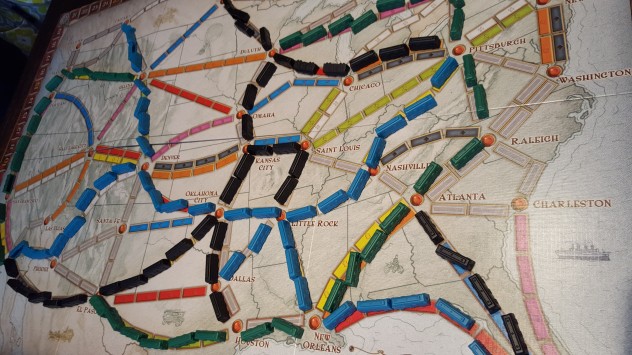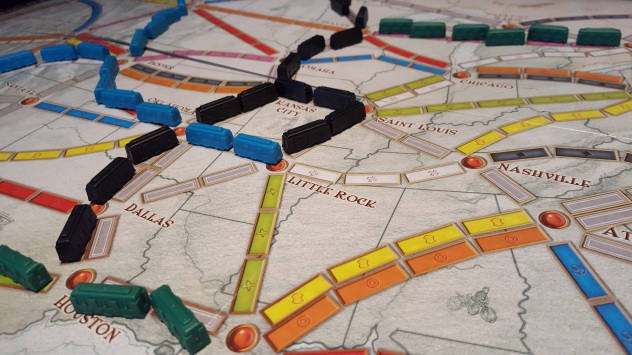Around since 2004, Ticket to Ride is an established fan favorite. I’m often asked for game recommendations for people who like to play games, but wouldn’t describe themselves as “serious gamers.” Well, look no further. Ticket to Ride is a perfect game for novices, experts, and everything in between.
[Source]
The Basics
Time: 30-60 minutes
Players: 2-5
Ages: 8+
BGG Rating: 7.5*
Baby Brown Bear Status: Owned (original and Ticket to Ride: Nordic Countries)
In Ticket to Ride (or TTR, as we affectionately call it), you and four of your old college buddies are racing by train to see who can visit the most U.S. cities–and claim the most routes– in just seven days. It’s a winner-takes-all competition for a $1 million prize, an especially astounding amount in 1900, when the game takes place.
The main game play mechanisms are card drafting and network building. The object of the game is to score the most points, which is done in three ways: claiming routes, successfully connecting cities on your destination tickets, and/or completing the longest continuous path of routes.
The game ends when any player has only 0, 1, or 2 trains left at the end of his or her turn. Each player, including that player, then has one final turn before scores are calculated.
*The top-ranked games have ratings of ~8.3/10.
Setup
The setup is quite simple. Here, you can see the major components.

Below the map, from left to right are: a player’s initial hand of four train car cards; a player’s initial hand of three destination tickets; and the pile of train car cards with the top five face-up.
Map
In the center of the table is the map (in the original game, it is of the U.S. as shown here). On the map are several train routes connecting various cities. The colored rectangles in any given route represent the number and color of train car cards needed to claim that route. For example, the route between El Paso and Houston requires six green train car cards.
Some of the routes are gray. This means that a player may choose any color train car card as long she has the specified number all in the same color.
There are also some double-routes. In games with two or three players, only one of the double-routes can be claimed. In games with four to five players, both routes can be claimed, but not by the same player.
Finally, surrounding the map is the scoring track, where players keep a running tally of the points earned from claiming routes.
Destination tickets
Each player is initially dealt three destination tickets and must keep at least two of them. The discarded destination tickets are placed on the bottom of the remaining cards and the deck is put off to the side of the board.
These cards contain the names of two cities and a point value. If the player successfully connects the two cities by the end of the game, she adds that point value to her score. If she does not successfully connect the two cities, she subtracts that point value from her score. These cards should be kept secret so your competitors cannot see where you are trying to go. This is important because your strategy should be largely based on your destination tickets.
Train car cards
Each player is initially dealt four train car cards. The rest of the deck should be set to the side of the board and the top five cards should be placed face-up on the table. There are eight types of train car cards that represent the colors of routes on the map. There are also locomotive cards that act as wild cards and can be used to complete any route (the locomotive card is the rainbow-colored card in the above picture).
Trains
Finally, each player chooses a color and takes the corresponding set of 45 trains and scoring marker. The scoring marker is placed along the scoring track (beginning at zero). Optionally, the trains are lined up in a pretty little row, as shown below.
Always bet on blue.
Turn summary
According to the rules, the most experienced traveler begins. In clockwise order, each player can do one the following. Remember, these are simplified rules to give you a flavor of the game. Before you play, make sure you read the real rule book.
- Draw train car cards. A player can draw two train car cards from the face-up pile or she can blindly draw from the top of the deck. Face-up cards must be immediately replaced. If a locomotive card is face-up and a player wants it, she may only draw that one card. If the locomotive card is drawn from a blind draw, the player may still draw two cards (and consider herself lucky).
- Claim a route. A player can claim a route by turning in a set of train car cards that match the number and color of the desired route. She then places her trains on the route spaces. Finally, she scores her route according to the scoring table printed on the board and moves her scoring marker accordingly.
- Draw destination tickets. A player may draw three destination tickets, keeping at least one of them. This is a good strategy if the game is still young and she has completed all her other destination cards already.
Again, this continues until a player has only 2 or fewer trains left in her stock. Each player then has one more turn and final scores are calculated (taking into account completed or uncompleted destination tickets and the longest route).

My Thoughts
Another easy one, and I think you know how it’s going to go.
Cons
- Spite. If other players are able to detect where you are trying to go, they are able to cut you off by claiming the route you need. Since there are so many single routes connecting cities you need to reach for your destination tickets, this can be a real pain in the ass, especially when it’s done out of spite and not necessity.
Pros
- Family friendliness. Yes, this is another train game, but it’s a lot easier to set up, learn, and start than Snowdonia. Like I mentioned at the start of this post, it appeals to people of all ages, interests, and game-playing experience. There’s hardly any learning curve, scoring is straightforward, and it encourages a lot of interaction with other players. The theme is light enough to make it fun and engaging, and yet it requires enough strategy to be interesting. This is one of the only family friendly strategy games I regularly play that requires those meaningful decisions I discussed previously.
- Fast-paced action. Because this game is pretty easy to learn, it means you don’t have a lot of analysis paralysis. In turn, it moves quickly and you’re able to keep up without issue, even if you’re just starting.
- So many versions! I mentioned above that we have Ticket to Ride: Nordic Countries in addition to the original game, and we love it just as much. There are many different versions of this game, with new maps, slightly different rules, and unique player counts.
- Wanderlust. I always feel a sense of wanderlust when we play this game, regardless of which map we play. I absolutely love to travel, but since it’s not entirely practical (or affordable) to travel nonstop, I can usually–temporarily–scratch the itch with a quick game of TTR.
In short
This is a great game to have in your personal collection. If you’re not ready to commit, check it out at your local game store. No self-respecting game store would be complete without it in their trial library. It’s a classic game, respected–if not loved–by every board game fan I know, yours truly included. I’m already looking forward to the day I can teach Baby Bear how to play.
Are you a TTR fan, too? Which version is your favorite?



This game I would try! 8+, I think I could handle it 🙂
LikeLike
You could handle any of these I write about. I promise!
LikeLike
I have played this game before!! I think I almost won too 🙂
LikeLike
Awesome!! Thanks for reading! 😀
LikeLike